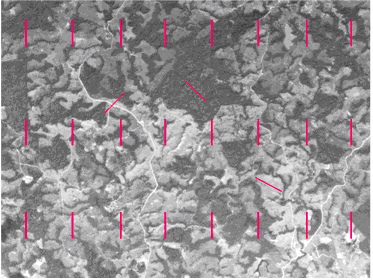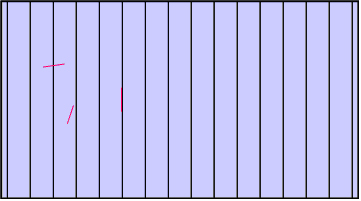Line sampling
Contents |
Introduction
Line sampling uses one-dimensional lines as observation units, just as we may use for many purposes fixed area sample plots (two-dimensional observation units) or points (dimensionless observation units). Line sampling does here not refer to the so-called transects which usually mean elongated narrow strips, that is: two-dimensional plots. Depending on the dimensionality of the observation units, different types of observations can be made on them. There are three major uses of line sampling:
- It may be observed which portion of a sample line comes to lie in forest. These portions can be used to estimate the forest cover percent. This type of sampling is called line intercept sampling.
- It may be observed how many times a sample line intersects with a line feature in the landscape such as forest edges, roads or creeks. The number of intersections can be used to estimate the total length of these line features. This type of sampling is called line intersect sampling.
- It may be observed whether a population element is intersected or not by a sample line. By this, we may use the line samples to make a random selection of population elements in the absence of an a priori sampling frame.
A good reference for line sampling is deVries (1986) or earlier related studies by deVries.
Line intercept sampling
Line intercept sampling is used to estimate the cover of defined classes in the landscape, for example forest or forest types. Line samples are randomly placed over the area of interest and on each sample line it is observed which proportion comes to lie in the target area class. The observation per sample line can take on values between 0 and 1. From these observations, the mean, variance and error variance can be estimated along the known estimators. Line intercept sampling is typically applied in aerial photographs when rapid area estimations are desired. However it is also applied in the field: in large area forest inventory cluster sampling, one may use, for example, the connecting lines between sub-plots to do line intercept sampling. Figure 1 illustrates this approach by overlaying a systematic sample of equally oriented lines of n = 24 and a random sample of randomly located and randomly oriented lines of n = 3.
Let \(l_{i(in)}\) be the length of the sample line i which is inside the target condition class such as forest, \(l_{i(total)}\) be the total length of the sample line i; then, the observation \(y_i\) which is made on line i is
- \[y_i = \frac {l_{i(in)}} {l_{i(total)}}\].
The estimated proportion \(\hat p\) in the region off interes is then estimated from n randomly placed sample lines from
- \[\hat p=\frac {\sum_{i=1}^n y_i}{n}\]
and the variance in the population is estimated from
- \[s^2=\frac {\sum_{i=1}^n (y_i - \hat p)^2}{n-1}\].
The error variance is \(s_p^2 = \frac {s^2}{n}\).
These estimators hold for random sampling and sample lines of the same length. It may be that sample lines have different length; for example if the lines cross the entire region of interest and are randomly placed. Then, the ratio estimator may be applied to increase the precision of estimation, using the length of the individual sample line as ancillary variable.
Line intersect sampling
The terms line intersect sampling and line intercept sampling should not be confused: line intersect sampling bases on counting intersections of the sample lines with line features in the landscape. It is obvious that there will be more intersections with line samples, the longer the line feature in the landscape is. By simply counting the intersections (and knowing the total length of the sample lines), one can then produce an estimation of the total length of the line feature. This is frequently used for the estimation of the length of the forest edge or for the length of the road network in a region of interest in which that sample line is located. Line intersect sampling goes back to an experiment from the 18th century:
Buffon’s needle problem (1777)
The French noble man Comte de Buffon researched into the basic questions: If a needle of length \(l_i\) is thrown randomly on an area completely covered by equidistant parallel lines with the distance W (and the line length \(l_i\) being shorter than W), what is the probability that the needle intersects with one of the parallels.
This is illustrated in Figure 2. The solution follows the standard procedure when determining probabilities: we must try and define the size of the total population of needles and then identify that part of the population of needles that intersect with one of the parallels. The ratio of these two is the searched probability.
The motivation of Mr. Buffon was obviously to investigate the characteristics of gambling.
This problem can be solved by geometric probabilities and is illustrated in Figure 3 on the left, where we concentrate on only one of the parallels. After this, the position of a particular needle ee′ relative to the parallels is defined
- by the center point M of the needle and its distance m to the nearest parallel, and
- by the orientation, that is the angle φ between the orientation of the needle and the orientation of the parallels.
About the line shown in Figure 3, a rectangle is centered with the width W and the length L; remember W is the distance between the parallels and L is the total length of the parallel. Within this rectangle, only specific combinations of the above mentioned factors do lead to an intersection of the needle with the centered line. That means: as a function of these two factors, one can determine whether the needle intersects or not. The population of needles is defined by all points of the area of interest and for each point by all possible orientations; where the area of interest is formed by the rectangle WL. If the distance of the needle from the parallel is larger than \(l_i/2\), an intersection is not possible at all so that we can subdivide the area of interest from the outset in two domains: Needle positions nearer than \(l_i\) to the parallel (here, the intersection depends on the angle φ) and those farther away than li for which the intersection is impossible.
Because of symmetry it is sufficient to investigate what happens at one side of the perpendicular line, and it is sufficient to look at angles φ from 0 to 90°, or in radians from 0 to \(\frac {\pi}{2}\). Thus, it is imperative that
- \[0 \le m \le \frac {l_i}{2}\] and \(0 \le \varphi \le \frac {\pi}{2}\),
where m and φ are stochastically independent variables and equally distributed in the correspondent intervals. We can now identify those combinations of m and φ for which an intersection takes place. To do so, let’s introduce the distance x between the midpoint M of the needle and the intersection point S (Figure 3, left), for which it is imperative that
- \[x \le \frac {l_i}{2}\].
The variable x is a function of m and φ and can, thus, be replaced by
- \[\frac {m}{sin \varphi}\]
what finally results in
- \[m \le \frac{l_i}{2}sin(\varphi)\].
As a result, for all needle positions / combinations below the line
- \[m = \frac{l_i}{2}sin(\varphi)\]
an intersection takes place (Figure 3 right). That graph can also be read as follows: imagine a fixed value for the distance \(m_x\), represented by a parallel to the abscissa passing through the value \(m_x\) at the y-axis; for all values of φ left to the intersection with the function, there is no intersection with the parallels, but there is intersection for all angles φ right to the intersection with the function.


